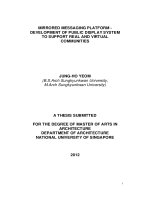Response of sweet corn hybrid to establishment methods and weed management practices under temperate conditions
Bạn đang xem bản rút gọn của tài liệu. Xem và tải ngay bản đầy đủ của tài liệu tại đây (546.57 KB, 9 trang )
Int.J.Curr.Microbiol.App.Sci (2019) 8(2): 1301-1309
International Journal of Current Microbiology and Applied Sciences
ISSN: 2319-7706 Volume 8 Number 02 (2019)
Journal homepage:
Original Research Article
/>
Response of Sweet Corn Hybrid to Establishment Methods and Weed
Management Practices under Temperate Conditions
Shayista Fayaz1*, Nazir Ahmad Teeli1, Ashaq Hussain1, Manzoor A. Ganai1,
Shakeel Ahmad Mir2 and Zahoor A. Baba3
1
Mountain Research Centre for Field Crop (SKUAST-K), Khudwani,
Anantnag, (J&K), 192 102, India
2
Division of Agri-Statistics, Faculty of Agriculture (SKUAST- K), Shalimar,
(J&K), 190025, India
3
Division of Soil Science and Agricultural Chemistry, Faculty of Agriculture (SKUAST-K),
Wadura, Sopore (J&K), 193201, India
*Corresponding author
ABSTRACT
Keywords
Direct seeding,
Transplanting,
Herbicide, Quality,
Sweet corn, Yield
Article Info
Accepted:
12 January 2019
Available Online:
10 February 2019
A field experiment on “Response of Sweet corn hybrid to establishment methods and weed
management practices under temperate conditions” was conducted at research farm of Faculty
of Agriculture (SKUAST-K) kharif during 2017. The treatments comprised of three
establishment methods (Transplanting polypot (TP),Transplanting nursery (TN) and Direct
Seeding (DS) and six weed management practices (Atrazine @ 1.5 kg a.i. ha -1 as pre emergence
+ hand weeding and intercultivation at 30 days after sowing (W1), Pendimethalin @ 1.0kg a.i.
ha-1 as pre emergence + hand weeding and intercultivation at 30 days after sowing DAS (W2),
Pendimethalin @ 1.0 kg a.i. ha-1 pre emergence + Sulfosulfuran 60 g a.i. ha-1 as post emergence
at 30 DAS (W3), Atrazine @ 1.5 kg a.i. ha-1 as pre emergence +Tumbotrione 120 g a.i. ha-1 as
post emergence at 30 DAS (W4), Weed free (W5), Weedy check(W6) laid out in RCBD with
three replications. Sweet corn variety Sugar-75 of Syngenta was used as the test variety. The
seedling parameters were significantly superior in transplanting polyplot sown in green house.
All the growth parameters (viz. plant height, dry matter production, leaf area index), days to
tasseling, days to silking and yield parameters viz. number of cobs plant-1, number of grains
cob-1, green cob yield and stover yield and harvest index) were observed to be significantly
higher in transplanting polyplot. The plant height, leaf area index, dry matter accumulation and
number of leaves were observed to be significantly higher in treatment of atrazine @ 1.5 kg a.i.
ha-1 as pre emergence + tembotrione 120 g a.i. ha-1 as post emergence at 30 DAS (W4). Yield
parameters viz., green cob yield and green fodder yield increased significantly in treatment of
atrazine @ 1.5 kg a.i. ha-1 as pre emergence + tembotrione 120 g a.i. ha-1 as post emergence at
30 DAS (W4). It can concluded that under existing conditions transplanted polypot in
combination with application of atrazine @ 1.5 kg a.i. ha-1 (pre-emergence) + tembotrione @
120 g a.i. ha-1 (post-emergence) (TPW4) showed highest benefit cost ratio of 7.97 and proved
superior for realizing higher yield and profitability of sweet corn under temperate conditions.
1301
Int.J.Curr.Microbiol.App.Sci (2019) 8(2): 1301-1309
Introduction
Sweet corn is the new age super diet for
health conscious people. The nutritive value
of sweet corn is comparable to several high
priced vegetable like cauliflower, cabbage,
french beans, fiber content and low in
cholesterol (Yodpetch, 1979), it offers even
greater health benefits when cooked. The
Sweet corn's antioxidant activity is
significantly increased when cooked, helping
to battle cancer, heart disease and protect
against cataracts. It is one of the most popular
vegetable in the western and advanced
countries of the world (ICAR, 2006). The
awareness about sweet corn in Kashmir valley
is also growing gradually and may increase
further with the growth in tourism industry.
Abundant sunshine, moderate temperature
and nearly pest free environment of Kashmir
valley is suited for high quality and yield of
sweet corn. In Kashmir valley, due to low
prevailing temperature in the month of April
and May, high soil moisture due to excessive
spring rainfall coupled with cutworm
infestation, direct seeding often becomes a
difficult as seed suffers from bird damage and
poor germination resulting in loss of costly
seed. Raising the seedlings in polypots root-1
trainers under protected conditions is one of
the alternatives that need to be explored.
Transplanting ensures maximum crop stand
establishment, early flowering, maximum
biomass production and more grain yield as
compared to direct seeding. It is best method
to get maximum crop plants under similar
conditions. The advantages of transplanting
are a reduced mortality compared with direct
seeding, scope for the selection of strong and
healthy seedlings to ensure a better plant
stand and economies in the seed rate. In
transplanting plastic plug trays are used as an
alternative of direct seeding and the effect of
sowing date for different sweet maize mutants
has been evaluated. Sweet maize mutants
hybrids Canner (su1), Butter Sweet (sh2) and
Cheyenne (se1) were sown in spring and
summer by direct seeded or in plastic plug
trays (128 cells tray-1) for transplant. Present
results suggest that it was possible to obtain
similar or higher yield from sweet corn maize
mutant plants using a transplant method than
direct-seeded under optimal environments
(Rattin et al., 2006).
The growth conditions can be made
favourable for the crop through effective use
of weed management practices. The
combination of pre emergence and new post
emergence herbicide with hand weeding and
inter-cultivation operations need to be
evaluated for their effect on sweet corn and its
associated weed flora. Weed management
strategies attempt to limit the deleterious
effects of weeds growing with crop plants.
Therefore a field investigation on the
establishment methods and weed management
practices was conducted to evaluate the
seedling quality and optimize the different
establishment methods and weed management
practices for higher growth and yield and
profitability of sweet corn.
Materials and Methods
A field experiment was conducted at Faculty
of Agriculture, Wadura, Sopore to investigate
the response of sweet corn to establishment
methods and weed management practices on
the yield and quality of sweet corn. It is
located at latitude of 34° 34´ N, longitude
74°40´ E and altitude of 1590 m amsl. The
soil of the experimental field was silty clay
loam in texture, neutral in reaction, low in
available N (210 kg/ha) and P (12.3 kg/ha)
and medium in available K (183.5kg/ha).
Treatments comprised of three establishment
methods
(Transplanting
polypot,
Transplanting nursery and Direct seeding) and
six weed management practices ((Atrazine @
1302
Int.J.Curr.Microbiol.App.Sci (2019) 8(2): 1301-1309
1.5 kg a.i. ha-1 as pre emergence + hand
weeding and intercultivation at 30 days after
sowing (W1), Pendimethalin @ 1.0kg a.i.. ha-1
as pre emergence + hand weeding and
intercultivation at 30 days after sowing DAS
(W2), Pendimethalin @ 1.0 kg a.i.. ha-1 pre
emergence + Sulfosulfuran 60 g a.i.. ha-1 as
post emergence at 30 DAS (W3), Atrazine @
1.5 kg a.i.. ha-1 as pre emergence
+Tumbotrione 120 g a.i. ha-1 as post
emergence at 30 DAS (W4), Weed free (W5),
Weedy check (W6) laid out in RCBD with
three replications. Sweet corn variety Sugar75 of Syngenta was used as the test variety.
The seeds were sown in greenhouse on 11th
May in
transplanted
polybags
and
transplanted nursery respectively and
transplanted at an age of 20 days and sowing
in main field was done at 15th May. Seedlings
were raised under protected in poly bags
using potting mixture of 400 g of soil: sand:
manure in the ratio of 2:1:1.
The poly bags were teared at the time of
transplanting without disturbing the soil. A
spacing of 60 cm x 20 cm was used, Before
sowing, full dose of nitrogen, phosphorus and
potassium at the rate of 120 N, 40 P2O5 and
20 K2O kg ha-1, respectively through Urea,
Di-ammonium Phosphate (DAP) and Murate
of Potash (MoP) was applied uniformly to
each plot as basal dose.
Germination percentage and Seedling
vigour was calculated as per the following
formulae
Germination percentage= Total number of
seeds germinated/ Total number of seeds
sown×100
Seedling vigour index I
Vigour index I = Germination% × Seedling
length
Seedling vigour index II
Vigour index II = Germination% × Seedling
dry weight (Abdulbaki and Anderson, 1973).
Results and Discussion
Seedling quality parameters
All the seedling parameters viz., seedling
shoot length, seedling root length, seedling
fresh and dry weight, germination percentage,
number of leaves, seedling vigour index I and
II were found to be significantly superior in
transplanted polypot (Table 1). Therefore, it is
fundamental to determine the optimum
temperature for the plant. Higher temperature
associated with seedlings in greenhouse in
polypot sowing resulted in high growth rate of
the seedlings and thus higher values of various
seedling parameters were obtained. Inglett
(1970) and Bunting (1971) reported that most
maize seed germinated slowly below 10oC and
germination increases drastically in the higher
temperature regimes. Di Benedetto et al.,
(2006) also reported that germination rate and
emergence would be enhanced by a
transplanted technique.
Growth attributes
The data pertaining to the growth parameters
viz. plant height, dry matter production, leaf
area index, no of functional leaves viz. were
observed to be significantly higher in
transplanted polypot than direct seeding and
transplanting nursery (Table 2).
Plant height
Plant height is an important growth index to
study the accumulation of dry matter by the
plant. Plant height was significantly affected
by establishment methods. There was a
consistent increase in plant height of sweet
corn till harvest (Table 2). Transplanted
1303
Int.J.Curr.Microbiol.App.Sci (2019) 8(2): 1301-1309
polypot showed highest plant height as
compared to direct seeding and transplanted
nursery. Direct sowing plants showed lower
plant height because they entered generative
earlier as of heat increase.
The results are in close conformity with those
of Idikut (2013), Cesur and Tosun (2005) and
Williams (2008).
Number of leaves
Number of leaves per plant at 15 days interval
during crop growth was significantly
influenced by establishment methods upto 45
days after sowing, transplanted polypot
sowing registered more number of leaves
plant-1 due to ideal growth conditions (Table
2). Our findings are in close conformity with
results of Chudasama et al., (2017).
Leaf area index
Among different establishment methods
transplanted polypot showed highest leaf area
index (5.71) at 60 DAS than direct seeding
and transplanted nursery.
Plants transplanted with lesser aged seedlings
resulted in more LAI and root volume which
contributed towards increased source- sink
relationship within the plants and resulted in
more dry matter accumulation. The results are
in confirmation with the results related
reported by Town Phung (2004) and Kumar et
al., (2012).
Dry matter accumulation
However, less aged seedlings in transplanted
polypot (TP) resulted in more leaf area which
contributed towards increased source-sink
relationship and resulted in more dry matter
accumulation. The results are in confirmation
with the results reported by Kumar et al.,
(2012).
Effect of weed management practices on
Growth attributes
Plant height
Weed management practices have a profound
effect on plant height (Table 2). Among
herbicides atrazine 1.5 kg a.i. ha-1 as pre
emergence + tembotrione 120 g a.i. ha-1 as
post emergence at 30 DAS (W4) recorded
higher plant height which was at par with
other treatments of herbicides as tembotrione
is a selective post-emergence herbicide for the
control of broad leaf and grassy weeds in
maize.
The possible reason for beneficial effect could
possibly be attributed to higher weed-control
efficiency with these treatments resulting in
more favorable environment for growth and
development of crop plants apparently due to
lesser weed competition which led to increase
height of maize plant. Our results in
conformity with the results of Singh et al.,
(2012).
Number of leaves
Weed management practices have a profound
effect on plant height (Table 2). Among
herbicides atrazine 1.5 kg a.i. ha-1 as pre
emergence + tembotrione 120 g a.i. ha-1 as
post emergence at 30 DAS (W4) recorded
highest number of leaves which is at par with
weed free treatment (W5) as tembotrione is
broad spectrum herbicide and is effective in
controlling weeds reduces crop weed
competition. These results are in line with
Akhtar et al., (2015).
Leaf area index
Atrazine 1.5 kg a.i. ha-1 as pre emergence +
tembotrione 120 g a.i. ha-1 as post emergence
at 30 DAS (W4) recorded highest number of
leaves which is at par with weed free
1304
Int.J.Curr.Microbiol.App.Sci (2019) 8(2): 1301-1309
treatment (W5) and thereby increase in
nutrient uptake by improving the leaf area.
Similar findings were reported by Angiras
and Singh (1989) and Mundra et al., (2002).
Dry matter accumulation
Dry matter accumulation of crop showed
significant variation with respect to weed
management practices at 15 days interval of
the crop growth (Table 2).
Table.1 Effect of Establishment methods on different parameters of seedlings of sweet corn
Establishment Shoot
methods
length
(cm)
20.69
TP
17.44
TN
18.46
DS
SEm+
0.99
CD(p<0.05)
2.97
Root
length
(cm)
14.54
11.58
12.52
0.96
2.88
Fresh
weight
(g)
5.43
4.15
4.37
0.20
0.57
Dry
weight
(g)
2.23
1.48
1.65
0.08
0.23
Number Germination Vigour
index-I
of leaves (percent)
Vigour
4.48
3.77
4.37
0.15
0.45
209.99
129.14
151.81
17.03
49.15
94.17
87.26
92.01
0.71
2.06
3198.01
2600.34
2850.46
79.81
230.37
index-II
Transplanting polypot: TP, Transplanting nursery: TN, Direct Seeding: DS
Table.2 Effect of establishment methods and weed management practices on growth parameters
of sweet corn
Treatments
Plant
height
Leaf area No.
index
functional
leaves
of Dry
matter
accumulation
(t/ha)
Establishment Methods
TP
TN
DS
SEm±
CD(≤ 0.05)
286.00
259.22
264.82
1.34
3.86
4.89
3.20
4.00
0.033
0.09
11.34
8.85
10.82
0.095
0.27
176.39
105.28
128.25
1.50
4.35
3.83
3.98
4.18
4.29
4.32
3.70
0.046
0.13
9.93
10.14
10.40
10.52
10.57
10.44
0.134
0.39
124.27
131.07
136.54
146.04
151.47
117.45
2.13
6.15
Weed management
W1
W2
W3
W4
W5
W6
SEm±
CD(≤ 0.05)
269.59
271.51
273.67
277.00
288.55
257.23
1.89
5.46
Transplanting polypot: TP, Transplanting nursery: TN, Direct Seeding: DS, W 1: kg a.i ha-1 as
PRE+Hand weeding (HW) + IC (Intercultivation) at 30DAS, W 2: Pendamethalin @1.0 kg a.i ha-1 as PRE + HW +
IC at 30 DAS, W3: Pendamethalin @1.0kg ha-1 as PRE+ Sulfosulfuron 60 g a.i ha-1 as post at 30DAS, W4: Atrazine
@1.5kg a.i ha-1 PRE +Tembotrione @ 120 g ha-1 as post emergence at 30 DAS, W5: Weed free, W6: Weedy check.
1305
Int.J.Curr.Microbiol.App.Sci (2019) 8(2): 1301-1309
Table.3 Effect of Establishment methods and weed management practices on number of cobs
plant-1, number of rows cob-1, number of grains row-1, number of grains cob-1, Cob length (cm),
Cob girth (cm) at different growth stages of sweet corn
Treatment
No of
cobs
plant-1
Establishment methods
1.83
TP
1.07
TN
1.28
DS
SEm±
0.02
CD(P≤0.05)
0.06
Weed management
1.31
W1
1.36
W2
1.41
W3
1.50
W4
1.54
W5
1.25
W6
SEm±
0.03
CD(P≤0.05)
0.09
No of
rows
cob-1
No
of
grains
row-1
Number
of grains
per cob-1
Cob length(cm)
With
Without
husk
husk
Cob girth (cm)
With
Without
husk
husk
18.12
17.00
17.51
0.11
0.34
26.58
20.58
23.35
0.31
0.89
486.33
334.58
414.91
6.93
20.09
29.61
23.05
27.22
0.48
1.39
26.61
20.05
23.72
0.47
1.36
18.40
16.29
17.25
0.06
0.17
15.21
13.09
13.99
0.05
0.16
17.06
17.36
18.20
18.60
18.71
15.33
0.16
0.48
21.55
23.50
24.04
25.28
26.25
19.89
0.44
1.26
369.35
410.70
438.71
472.32
492.26
305.13
9.80
28.31
25.11
26.11
27.66
29.11
29.89
21.89
0.68
1.97
22.00
22.77
24.55
26.00
26.67
18.77
0.68
1.93
16.77
17.28
17.54
18.04
18.36
15.86
0.08
0.24
13.58
14.08
14.34
14.81
15.16
12.60
0.08
0.23
Transplanting polypot: TP, Transplanting nursery: TN, Direct Seeding: DS, W 1: kg a.i ha-1 as
PRE+Hand weeding (HW) + IC (Intercultivation) at 30DAS, W 2: Pendamethalin @1.0 kg a.i ha-1 as PRE + HW +
IC at 30 DAS, W3: Pendamethalin @1.0kg ha-1 as PRE+ Sulfosulfuron 60 g a.i ha-1 as post at 30DAS, W4: Atrazine
@ 1.5 kg a.i ha-1 PRE +Tembotrione @ 120 g ha-1 as post emergence at 30 DAS, W5: Weed free, W6: Weedy check
Table.4 Effect of establishment methods and weed management practices on weight cob-1 (with
and without husk), husk corn ratio
Treatment
TP
TN
DS
SEm±
CD (P≤0.05)
W1
W2
W3
W4
W5
W6
SEm±
CD (P≤0.05)
Cob weight(gram)
With husk
397.77
295.55
353.44
7.94
22.92
338.11
343.77
361.88
377.33
400.88
283.55
11.23
32.41
Husk:corn ratio
Without husk
377.00
275.00
326.38
5.23
15.07
318.00
324.00
343.00
357.33
382.55
231.88
15.10
45.01
1.32
1.17
1.22
0.028
0.08
1.23
1.24
1.25
1.26
1.27
1.18
0.040
NS
Transplanting polypot: TP, Transplanting nursery: TN, Direct Seeding: DS, W1: kg a.i ha-1 as
PRE+Hand weeding (HW) + IC (Intercultivation) at 30DAS, W 2: Pendamethalin @1.0 kg a.i ha-1 as PRE + HW +
IC at 30 DAS, W3: Pendamethalin @1.0kg ha-1 as PRE+ Sulfosulfuron 60 g a.i ha-1 as post at 30DAS, W4: Atrazine
@ 1.5 kg a.i ha-1 PRE +Tembotrione @ 120 g ha-1 as post emergence at 30 DAS, W5: Weed free, W6: Weedy check
1306
Int.J.Curr.Microbiol.App.Sci (2019) 8(2): 1301-1309
Fig.1 Effect of establishment methods on green cob yield at harvest stages of sweet corn
Fig.2 Effect of weed management practices on green cob yield at harvest stage of sweet corn
Atrazine 1.5 kg a.i. ha-1 as pre emergence +
tembotrione 120 g a.i. ha-1 as post emergence at
30 DAS (W4) recorded highest dry matter
accumulation which is at par with weed free
treatment (w5) it might be due to atrazine as pre
emergence along with tembotrione as post
emergence resulted in excellent control of
grassy weeds and thereby results increase in
nutrient uptake by improving the leaf area, and
more leaf area contributed increased source sink relationship and in this way resulted more
dry matter accumulation (Akhtar et al., 2015).
Yield and yield attributes influenced by
establishment methods
Yield viz. number of grains/cob, cobs/plant, cob
length and cob girth was significantly higher in
transplanted polypot. Maximum cob length,
number of grains cob-1, cobs plant-1 and cob
girth, cob weight (with and without husk) was
recorded in transplanted polypot (Table 4).
1307
Int.J.Curr.Microbiol.App.Sci (2019) 8(2): 1301-1309
Three weeks old seedling recorded significantly
maximum number of cob length, cob girth, cob
weight and grains cob-1 as due to high dry
matter accumulation in transplanted polypots
resulting in increased yield attributes.
Similarly (green cob yield, green fodder yield
and harvest index) were observed to be
significantly higher in transplanting polypot
(Fig. 1 and Table 4). The increase in grain yield
(green cob yield) could be attributed to higher
yield attributes and increase in biological yield
might be due to higher leaf area index and dry
matter accumulation. Among establishment
methods transplanted polyplot show highest
grain yield as compared to direct seeding and
transplanted nursery. Seedlings raised in
green‐house planted in the field during or after
the optimum time matured earlier and could
give higher grain yields than direct seeded
maize. Higher values for yield attributes of
transplanted polypot ascribed to higher LAI, dry
matter production as well as translocation and
conversion of photosynthesis into reproductive
parts due to more root volume. The results are
in accordance with the results of Kumar et al.,
(2014) and Dhillon et al., (1990).
Yield and yield attributes influenced by weed
management practices
Yield contributing characters viz. number of
cobs plant-1, cob length, rows cob-1 and grains
row-1 varied significantly amongst different
weed management practices (Table 3). Atrazine
1.5 kg ha-1 pre emergence + tembotrione 120 g
ha-1 as post emergence at 30 DAS (W4) at par
with weed free (W5) reported significantly
higher green and stover yield due to higher leaf
area index, which resulted in more dry matter
accumulation and which in turn translocated to
sink in (W4) treatment (Fig. 2 and Table 4).
These results are also in close agreement with
previous findings of Dixit and Gautam, (1994)
and Martin et al., (2011).
Relative economics
In present investigation it was observed that
transplanting polyplot with atrazine @ 1.5 kg
a.i. ha-1 as pre + tembotrione 120g a.i. ha-1 as
post emergence at 30 DAS recorded higher net
returns and benefit cost ratio 542230 and 7.97,
respectively. The reason was higher number of
cobs and green fodder yield in this treatment
combination than others without any addition in
cost of cultivation. The results are in line with
those of the results reported by (Triveni et al.,
(2017).
It may be concluded that transplanting polypot
in combination with atrazine @ 1.5 kg a.i. ha-1
(pre-emergence) + tembotrione @ 120 g a.i. ha1
(post-emergence) produced significantly
higher grain and fodder yield.
References
Abdulbaki, A.A., and Anderson, J.D. 1973.
Vigour determination in soybean seed by
multiple criteria. Crop Science. 13:
630‒633.
Akhtar, P., Kumar, A., Kumar, J., Sharma, A.
K. and Bharti, V. 2015. Efficacy of
tembotrione on mixed weed flora and
yield of spring maize under irrigated subtropical shiwalik foothills 25th AsianPacific Weed Science Society Conference
on “Weed Science for Sustainable
Agriculture,
Environment
and
Biodiversity pp. 266.
Angiras, N. N. and Singh, C. M. 1989. Effect of
weed control methods, cropping systems,
plant population and soil fertility levels
on nutrient removal and soil fertility
status of maize yield. Indian Journal of
Weed Science 21(1-2): 69-74.
Bunting, E. S. 1971. Plant density and yield of
shoot dry material in maize in England.
Journal of Agricultural Science 77: 175185.
Cesur, C. and Tosun, S. 2005. Effect of planting
dates and growing techniques on green
yield and some characters of sweet corn.
KSU Journal of Science and Engineering
8(1): 91-100.
Chudasama., V. N. Patel., V. J. Patel, P. K. and
1308
Int.J.Curr.Microbiol.App.Sci (2019) 8(2): 1301-1309
Patel., B. D. 2017. Feasibility of
transplanting Rabi maize (Zea mays L.)
varieties to varying age of seedling under
middle Gujarat conditions. Journal of
Pharmacognosy and Phytochemistry 6(5):
34-37.
Dhillon, B. S., Khehra, A. S., Brar, H. S.,
Sharma, R. K. and Malhotra, V. V. 1990.
Transplanting of maize during the winter
in India. Agronomy Journal 82: 41-47.
Di-Benedetto, A., Molinari. J. and Rattin, J.
2006. The effect of transplant in sweet
maize (Zea mays) II. Container root
restriction. International Journal of
Agricultural Research 1: 555-563.
ICAR. 2006. Hand Book of Agriculture. ICAR
Publication pp. 886.
Idikut, L. 2013. The effects of light,
temperature and salinity on seed
germination of three maize forms.
Greener Journal of Agriculture Science 3:
246-253.
Inglett, G. E. 1970. Corn culture, processing
and
products.
AVI
Publishing
Corporation, London, England pp. 360.
Kumar, S. and Shivani, K. S. 2014.
Performance of transplanted maize (Zea
mays) under varying age of seedling and
method of nursery raising in the midlands
of eastern region., Indian Journal of
Agricultural Sciences 84(7): 877-882.
Kumar, S., Shivani, M. K., Meena, M. K. and
Singh, S. S. 2012. Production potential
and plant water status in transplanted
maize (Zea mays L.) as influenced by
methods of seedling raising and age of
seedling under irrigated midlands of
Eastern India. International Journal of
Agricultural and Statistical Sciences 8(2):
697-704.
Mundra, S. L., Vyas, A. K. and Maliwal, P. L.
2002. Effect of weed and nutrient
management on nutrient uptake by maize
(Zea mays L.) and weed. Indian Journal
of Agronomy 47(3): 378-383.
Rattin, J., Benedetto, Di, A. and Gornatti, T.
2006. The effect of transplant in sweet
maize (Zea mays). I. Growth and Yield.
International journal of Agricultural
Research 1: 58-67.
Singh, V. P., Guru, S. K., Kumar, A. Banga, A.
and Tripathi, N. 2012. Bioefficacy of
tembotrione against mixed weed complex
in maize. Indian Journal of Weed Science
44(1): 1-5. Town, P. 2004. Transplanting
maize on wetland. FFTC Publication
Database. Springer Link-Journal article.
Town Phung. 2004. Transplanting maize on
wetland. FFTC Publication Database.
Springer Link- Journal article.
Triveni, U., Rani, Y. S., Patro T. S. S. K. and
Bharathalakshmi, M. 2017. Effect of
different
pre-and
post-emergence
herbicides on weed control, productivity
and economics of maize. Indian Journal
of Weed Science 49(3): 231-235.
Williams, M. M. 2008. Sweet corn growth and
yield responses to planting dates of the
north central United States. Horticulture
Science 43: 1775-1779.
Yodpetch, C. 1979. Studies on sweet corn as
potential young cob corn (Zea mays L.).
Ph.D. Thesis, Philippines.
How to cite this article:
Shayista Fayaz, Nazir Ahmad Teeli, Ashaq Hussain, Manzoor A. Ganai, Shakeel Ahmad Mir and
Zahoor A. Baba. 2019. Response of Sweet Corn Hybrid to Establishment Methods and Weed
Management Practices under Temperate Conditions. Int.J.Curr.Microbiol.App.Sci. 8(02): 13011309. doi: />
1309









